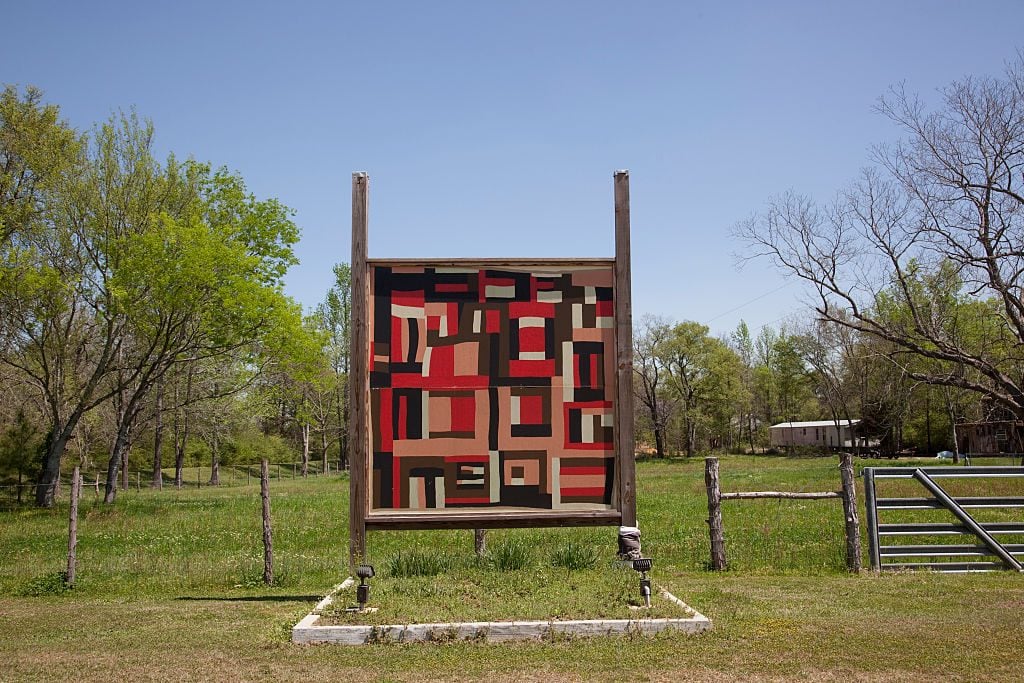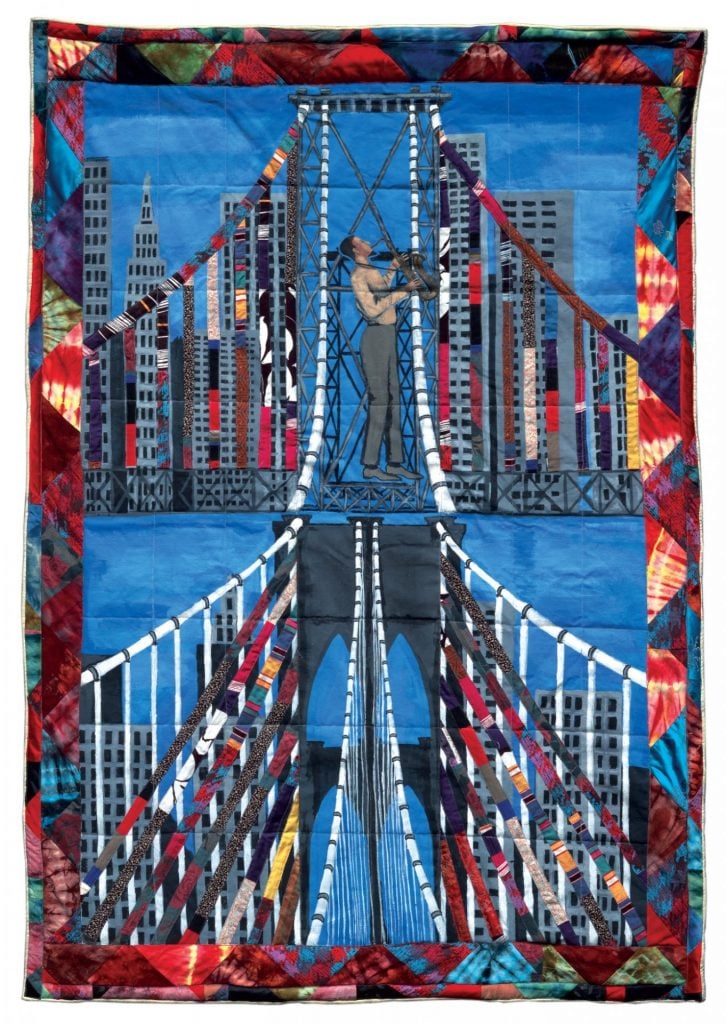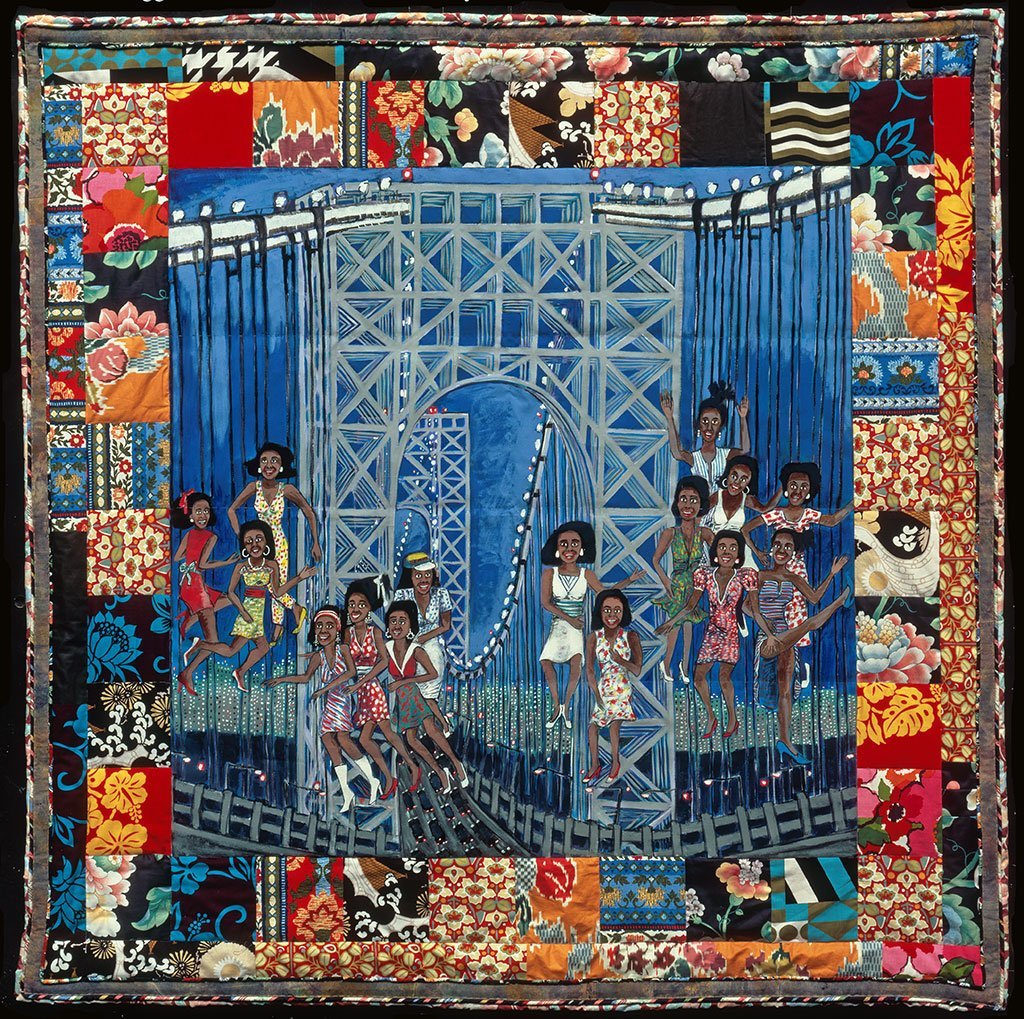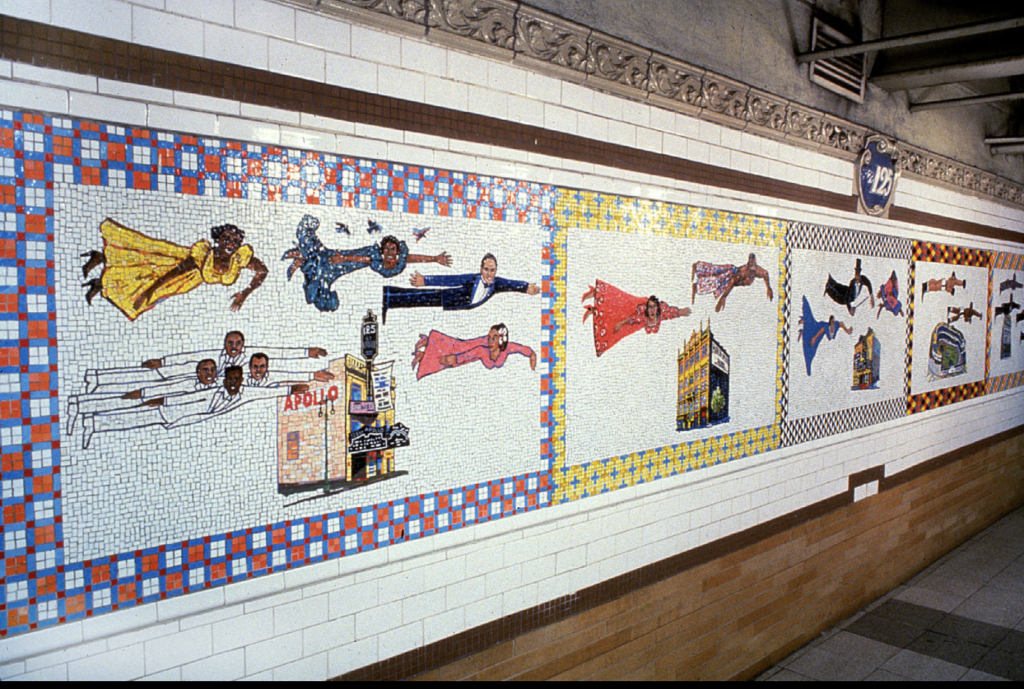Art History
Faith Ringgold’s ‘Tar Beach’ Is the Epitome of Summer Dreaming. Here Are Three Things to Know About This Classic Work of Art
Liberation is a key theme for the artist.

Liberation is a key theme for the artist.

Katie White

On a hot summer night in Harlem, Faith Ringgold’s heroine, eight-year-old Cassie Louise Lightfoot, takes flight over New York City, arms outstretched and the George Washington Bridge glittering like a necklace below her. Her mom, dad, baby brother Bebe, neighbors Mr. and Mrs. Honey—and even Cassie herself—can at once be seen below, relaxing on an apartment building’s rooftop under the stars. The image is Tar Beach (1988), the first quilt of five in Ringgold’s “Women on a Bridge” series of story quilts. Aside from the folkloric visual, we are guided through the work by lines of text, which fill the top and bottom of the quilt, speaking in Lightfoot’s voice. A few years after completing the quilt, in 1991, Ringgold would publish a children’s book directly inspired by it.
Over the decades, Tar Beach has become an urban childhood classic and the most famous of Ringgold’s 17 books for young readers, beloved for its universal themes of family, wonder, imagination, and awakening. Nevertheless, Tar Beach doesn’t shy away from the racial, political, and economic themes that define Ringgold’s oeuvre as a whole—and which kept her from a wider art-world embrace for many years. For Ringgold, the Tar Beach story quilt encapsulates the essence of emancipation and self-expression she has pursued across her works.
To mark the Juneteenth holiday, we’ve taken a closer look at Tar Beach. Here are three facts that reveal the artwork’s more radical implications.

A quilt on display in Gee’s Bend, Alabama. Photo: Carol M. Highsmith/Buyenlarge/Getty Images.
Quilting has a long cultural legacy in African American communities, most famously in the case of the women quilters of Gee’s Bend, Alabama. For Ringgold, the medium is intimately personal, too: She learned to quilt from her mother, who worked as a seamstress and designer. Ringgold’s great-great-grandmother, who had been enslaved in the American South, made quilts on the plantation. In this way, the medium reinforces a biographical reading. While considering this heritage, Ringgold’s unique style, with its folkloric figures and flattened perspectives, is simultaneously untraditional in her combination of quilting and painting on fabric.
“It is finely woven, very good quality, cotton duck canvas,” Ringgold explained of Tar Beach‘s materials in an interview with Craft in America. “Not linen, because linen is not appropriate for painting on this acrylic without gesso.”
Ringgold sourced her materials from stores around New York City. “I would go to the upholstery store and I would pick several different patterns of very well-made and colored upholstery fabric, so I didn’t have to worry about fading and stuff like that, and cut these blocks up,” she noted. Then she worked across a breadth of techniques—patchworking fabrics together, plotting out her designs, and painting onto the fabrics, in a process that was at once nuanced and spontaneous.
But more than showcasing technical wizardry, Ringgold’s story quilts remain focused on just that—storytelling. Here, too, the artist finds roots in African American traditions of “freedom quilts” of the Underground Railroad. Hung from clotheslines along the route north, these quilts were, some historians argue, filled with coded messages that helped guide enslaved African Americans to freedom. Though their histories and meanings are still very much up for debate, the concept of such symbolically laden quilts has lodged in the public imagination. One could say that Tar Beach acts in a similar way, embedding messages about gender, race, and personal liberation into a superficially whimsical scene of summertime relaxation and fantasy.

Faith Ringgold, Sonny’s Bridge (1986). © Faith Ringgold/ARS, NY and DACS, London, courtesy ACA Galleries, New York, 2022.
In many ways, Cassie Louis Lightfoot’s story mirrors the artist’s memories of growing up in Harlem as a young girl in the 1930s, a world in which the colossal George Washington Bridge—which connects Upper Manhattan with New Jersey—loomed large. Ringgold was born in 1930. Construction on the bridge that would dominate her skylines began in 1927 and opened to traffic in 1931, when the artist was still a baby. In her work, the bridge becomes a cultural reference point that she returns to time and time again.
“Daddy said that the George Washington Bridge is the longest and most beautiful bridge in the world, and that it opened in 1931, on the very day I was born. Daddy worked on that bridge, hoisting cables. Ever since then, I’ve wanted that bridge to be mine,” Cassie recounts in the narrative.

Faith Ringgold, Dancing on the George Washington Bridge (1988). Courtesy of ACA Galleries, New York.
For Ringgold, the George Washington Bridge embodied a muscular egoism and ambition that the artist embraced as her own and wanted for all women. “My women are actually flying; they are just free, totally. They take their liberation by confronting this huge masculine icon—the bridge,” explained Ringgold of the “Women on a Bridge” series.
“Now, I have claimed it. All I had to do was fly over it for it to be mine forever. I can wear it like a giant diamond necklace,” Cassie remarks. Like her young heroine, throughout her career, Ringgold has had to stake her claim in the art world time and again. As a girl, Ringgold had aimed to study studio art at City College of New York, only to arrive at age 18 to learn that women were not permitted into the fine arts program. She skirted this rule, however, by enrolling in the School of Education and majoring in art, on the advice of a woman in the enrollment office.

Faith Ringgold’s Flying Home: Harlem Heroes and Heroines (1996) is a mosaic artwork at the 125th Street station on the 2 and 3 subway lines. It alludes to the legend of “flying Africans.” Image courtesy of the City of New York.
In the last lines of Tar Beach, Cassie says of her ability to fly: “It’s very easy, anyone can fly. All you need is somewhere to go that you can’t get to any other way. The next thing you know, you’re flying among the stars.”
Though pretending to fly is an imaginative impulse shared by all children, Ringgold’s use of the trope also references the legends of “flying Africans,” which have existed in the oral traditions of Diasporic communities for generations. In such stories, Africans brought to the New World via the transatlantic slave trade would magically transport themselves back to Africa by an inborn gift of flight—a gift sometimes awakened through song. Some said this gift could be erased by the consumption of salt, often interpreted as a symbol for the saline-filled Atlantic Ocean.
Allusions to “flying Africans” appear in other of Ringgold’s works as well, including Flying Home: Harlem Heroes and Heroines, a mosaic installed in a subway station at 125th Street in Harlem, which shows great figures of the Harlem Renaissance floating high above the city. Many of these legends came to wider public attention with the release of recorded slave narratives in the 1930s. Zora Neale Hurston referenced them in her 1938 book Tell My Horse, as did Toni Morrison in her 1977 book Song of Solomon. Morrison, especially, has emphasized that the stories of flying Africans went beyond mythical symbolism and were widely and publicly believed.
“The story of flying Africans has been passed down from generation to generation since slavery—a secret, suppressed gift of our ancestors. While this myth has evolved over the years, it continues to be the source of imagination that depicts freedom, new futures, and returning to Africa,” wrote experimental documentarian Sophia Nahli Allison, in her New Yorker essay “Revisiting the Legend of Flying Africans.” “Rooted in the history of Igbo Landing—a site on St. Simon’s Island, in Georgia, where enslaved people brought from Nigeria revolted and walked together into the marshy waters, rather than be sold into slavery—these stories became both a truth that enabled survival and an oral archive of resistance. Flight became a secret language for runaway slaves, and it continues to represent black mobility toward liberation.”